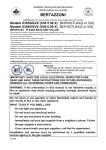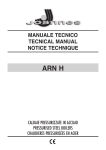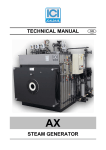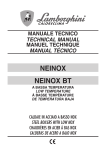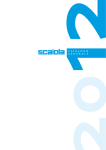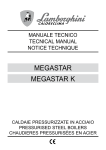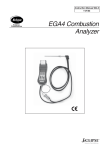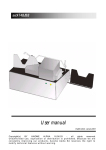Download Cal Flame 860 Professional Specifications
Transcript
TECHNICAL MANUAL NORLAND CONDENSING BOILER WITH BURNER LOW NOx STAINLESS STEEL CONDENSING BOILERS TABLE OF CONTENTS 1 GENERAL ...................................................................................................................................................2 2 GENERAL WARNINGS ..............................................................................................................................3 3 TECHNICAL SPECIFICATIONS .................................................................................................................4 3.1 4 INSTALLATION ............................................................................................................................................ 4.1 4.1.1 4.2 4.2.1 5 6 7 NORLAND 90 - 860 ........................................................................................................................ 5-6 HEATING SYSTEM..............................................................................................................................7 Boiler room ........................................................................................................................................................... 7 FLUE ....................................................................................................................................................7 Condensate drain ................................................................................................................................................. 7 4.3 WATER CONNECTIONS ....................................................................................................................7 4.4 ELECTRICAL CONNECTION ..............................................................................................................8 4.5 CONTROL PANEL ...............................................................................................................................8 4.6 STARTING ...........................................................................................................................................8 4.7 INVERTING THE DOOR APERTURE (MOD. 90/120) ........................................................................9 4.8 INVERTING THE DOOR APERTURE (MOD. 160 - 860 ) ..................................................................9 4.9 PRESSURISED BOILER CONNECTION ..........................................................................................10 4.10 WIRING DIAGRAM ............................................................................................................................10 FITTING THE BOILER CASING ...............................................................................................................11 5.1 BOILER BODY INSULATION ............................................................................................................11 5.2 BOILER CASING MOD. 90 - 120 .......................................................................................................11 5.3 BOILER CASING MOD. 160 - 270 ....................................................................................................12 5.4 BOILER COVERING MOD. 350 - 860) ..............................................................................................13 STARTING ................................................................................................................................................14 6.1 PRELIMINARY CHECKS ...................................................................................................................14 6.2 WATER TREATMENT .......................................................................................................................14 6.3 FILLING THE SYSTEM ......................................................................................................................14 OPERATION .............................................................................................................................................15 7.1 OPERATION CHECKS ......................................................................................................................15 7.2 TEMPORARY BOILER STOP............................................................................................................15 7.3 PROLONGED BOILER STOP ...........................................................................................................15 7.4 PERIODICAL USER CHECKS ...........................................................................................................15 7.5 MAINTENANCE AND CLEANING .....................................................................................................15 1 NORLAND 1 GENERAL The NORLAND boilers have a horizontal through-flame combustion chamber and a vertical condensing section of a special design, in stainless steel type AISI 316 Ti. These elements are immersed in water contained in a horizontal boiler drum with a vertical column to which the system inlet and outlet connections are fitted. These boilers reach very high efficiency levels as the flue gases not only are released at a temperature little higher than that of the system return water, but also a large part of the water vapour contained in the flue gases is condensed, recovering the latent heat of condensation. The particular flame path (through the combustion chamber without inversion) limits as much as possible the formation of Nitrogen Oxides (NOx) that form when the flame remains at high temperature in the combustion chamber for long periods. The Norland boilers place no limit on the return water temperature, and reach the highest performance when used with floor panel heating systems in which the return temperature is lower than 58C. At higher temperatures, condensation does not occur and so the recovery of the latent heat contained in the water vapour, present in the flue gas, is impossible. The efficiency of the boiler remains in any case high (97%) even with traditional high-temperature heating systems (∆t 82/71° C). The very high efficiency due to the complete recovery of the heat content of the fuel and to heavy thermal insulation of the boiler, using high density glass wool, allow classification of the Norland boilers as “4-Star - very high efficiency” as to the Efficiency Directive 92/42/CEE.. 2 NORLAND 2 GENERAL WARNINGS Each generator is provided with a data plate that can be found in the envelope with the boiler documents. The plate lists: • Serial number or identification code; • Rated thermal output in kW; • Furnace thermal output in kW; • Types of fuels that can be used; • Max operating pressure. A manufacturer's certificate is also provided which certifies the hydraulic test pressure. The installation must be performed in compliance with the regulations in force by professionally qualified personnel. The term “professionally qualified personnel” means persons with specific technical skills in the sector of heating system components. Incorrect installation may cause damage to persons, animals or objects for which the manufacturer cannot be held responsible. At the first start up, all regulation and control devices positioned on the control panel should be checked for efficiency. The guarantee shall be valid only upon compliance with the instruction given in this manual. Our boilers have been built and tested in observance of EEC requirements and, consequently, CE-marked. EEC directives are as follows: • • • • Directive on Gas 90/396/EEC Directive on Output 92/42/EEC Directive on Electromagnetic Compatibility 89/336/EEC Directive on Low Voltage 73/23/EEC IMPORTANT: This boiler has been designed to heat hot water to a temperature lower than the boiling point of water at atmospheric pressure and must be connected to a heating plant and/or a domestic hot water plant within the limits of the boiler performance and output. WARNING! THE BOILER MAY ONLY BE INSTALLED IN A ROOM WHICH COMPLIES WITH THE APPROPRIATE VENTILATION REQUIREMENTS. READ THE INSTALLATION AND USER INSTRUCTION BEFORE INSTALLING AND LIGHTING THE BOILER. Systems must be cleaned in accordance with British Standard Code of Practice BS 7593:1992, Code of practice for treatment of water in central heating systems. 3 NORLAND 3 TECHNICAL SPECIFICATIONS Model Outputs and Efficiencies Boiler output kW @ 50/30°C flow & return Boiler output kW @ 80/60°C flow & return Nom input kW net CV Efficiency % 50/30°C Flow/return 100% input Efficiency % 50/30°C Flow/return 30% input Efficiency % 80/60°C Flow/return 100% input Dimensions H H1 H2 H4 H5 H6 H8 H9 H10 L L1 L2 L6 P P1 P2 P3 P4 P5 P6 P7 P8 Øb Øc N1 N2 N3 N4 N5 N6 N7 N8 N9 90 120 160 200 270 340 450 560 700 780 860 95 120 158 203 266 343 445 559 699 775 851 87 110 145 186 244 313 406 511 639 709 779 88 107.9 112 107.1 147 107.5 189 107.4 248 107.2 319 107.5 414 107.5 520 107.5 650 107.5 721 107.5 792 107.5 109 109 109 109 109 109 109 109 109 109 109 98.9 98.2 98.6 98.4 98.4 98.1 98.1 98.3 98.3 98.3 98.3 1825 1734 1348 1825 1734 1348 1825 1734 1348 264 837 557 432 939 756 710 264 837 557 432 966 756 710 264 837 557 432 966 756 710 990 881 670 318 350 322 150200 1330 1221 1010 318 200 812 150200 1330 1221 1010 318 200 812 150200 1955 1941 1510 1952 2071 367 864 589 562 1063 853 814 150 1550 1296 1004 323 175 1052 150200 1955 1941 1510 1952 2071 367 864 589 562 1063 853 814 150 1550 1296 1004 323 175 1052 150200 150 180 50 50 R1 R1 150 180 50 50 R1 R1 150 200 65 65 R1 R1 180 200 65 65 R1 R1 180 200 80 80 R1 R1 R1/2 R1/2 R1/2 50 R1/2 R1/2 R1/2 50 R1/2 R1/2 R1/2 65 R1/2 R1/2 R1/2 65 R1/2 R1/2 R1/2 80 1955 1941 1510 1955 2105 367 864 589 562 1063 853 814 150 1801 1546 1254 323 195 1283 150200 150 150 180 250 100 100 R1 R1 R1.1/2 R1/2 R1/2 R1/2 100 2025 2008 1532 2025 2205 315 854 569 524 1201 991 932 200 1817 1577 1205 324 220 973 150200 150 150 225 250 100 100 R1 R1 R1.1/2 R1/2 R1/2 R1/2 100 2025 2008 1532 2025 2205 315 854 589 524 1201 991 932 200 2331 2092 1720 324 220 1487 150200 150 150 225 250 100 100 R1 R1 R1.1/2 R1/2 R1/2 R1/2 100 2025 2008 1532 2025 2205 315 854 569 524 1201 991 932 200 2331 2092 1720 324 220 1487 150200 150 150 225 250 100 100 R1 R1 R1.1/2 R1/2 R1/2 R1/2 100 2025 2008 1532 2025 2205 315 854 589 524 1201 991 932 200 2331 2092 1720 324 220 1487 150200 150 150 225 250 100 100 R1 R1 R1.1/2 R1/2 R1/2 R1/2 100 2025 2008 1532 2025 2205 315 854 569 524 1201 991 932 200 2331 2092 1720 324 220 1487 150200 150 150 225 250 100 100 R1 R1 R1.1/2 R1/2 R1/2 R1/2 100 4 NORLAND Mod. 90 - 125 Mod. 160 - 270 KEY N1 N2 N3 N4 N5 N6 Boiler flow Medium temperature return Fitting for Instruments System filling/drainage Safety valve(s) fitting Bulbs wells 5 N7 N8 N9 Boiler condensation drain Inspection well Low temperature return T Inspection plugs NORLAND Mod. 340 - 860 6 NORLAND 4 INSTALLATION Before connecting the boiler, carry out the following operations: • Clean carefully all the system pipe work to remove any residues that could damage impede correct boiler operation; • Check that the flue has sufficient draught, has no restrictions, is free of all soot and residues, and is perfectly gas tight in particular to the water vapour contained in the flue gas. Check further that no other devices are connected to the flue. Take account of applicable regulations in this regard. 4.1 HEATING SYSTEM 4.1.1 Boiler room The system must correspond to current applicable regulations. In all cases, the boiler must be installed in adequately ventilated rooms that also allow routine maintenance and repair work. 4.2 FLUE The pressurised boiler that is now a part of your heating system uses this denomination as the boiler includes a burner with a blower that supplies, to the combustion chamber, the quantity of air needed for the fuel, at a pressure equivalent to the sum of the air-flow pressure drops caused by the flue gas path. The boiler flue gas connection to the chimney base must be inclined, rising in the direction of flow, with a suggested slope not less than 10%. The path of this connection shall be as short and straight as possible, any bends being designed taking account of the rules used in designing air ducts. Chimneys must in any case be dimensioned according to Standard UNI 9615. WARNING The flue gas temperatures produced by MONOLITE boilers are considerably lower than in the case of non-condensing boilers, and have therefore very high relative humidity. For these reasons the chimney must be completely watertight, must withstand corrosion attack by acid condensate and must be adequately heat-insulated to guarantee sufficient draught. 4.2.1 Condensate drain Connect condensate drain: A siphon must be installed on the condensate drain pipeline to avoid flue gas leakage. 4.3 WATER CONNECTIONS Make sure that the water pressure downstream of the water supply pressure reducer is lower than the working pressure shown on the boiler data plate. − During operation, the water in the heating system increases in pressure; make sure therefore, that the maximum pressure reached does not exceed the maximum admissible pressure for the component as shown on the component number plate. − Make sure that the safety valve discharge fittings of the boiler and of any sanitary water heater are connected to the drains via an open funnel, so that if the safety valves open, the boiler room will not be flooded. − Make sure that the water and heating system pipe work are not used as a ground for the electrical system: if so, serious damage can be caused in a short time to the boiler, pipe work, water heater and radiators. − Once the heating system has been filled with water, close the water supply valve, and keep it closed. Any water leaks from the system will then appear as pressure drops, as shown by the system pressure gauge. NOTE: IF ONLY ONE RETURN IS REQUIRED, ALWAYS USE THE LOW TEMPERATURE ONE 7 NORLAND 4.4 ELECTRICAL CONNECTION The electrical system in a heating plant that is for building heating only, is the object of numerous regulations, some of which are general in character, others being specific to the type of application or type of fuel. 4.5 CONTROL PANEL The control panel supplied with the boilers is made of self-extinguishing plastic and houses the regulation and safety instruments: Fig. 1 LEGEND 1 2 4 7 8 9 11 PANEL LIVE BURNER SWITCH N. 1 HEATIN PUMP SWICTH BOILER THERMOMETER BOILER LIMIT THERMOSTAT SAFETY LIMIT THERMOSTAT nd 2 FLAME THERMOSTAT The upper part of the control panel can be rotated to gain access to the terminal board and uncoil the thermostat and thermometer capillaries. A copy of the wiring diagram is contained inside the control panel cover. The control thermostats (TR1-TR2) have an operating range from 0° to 90° and can be set by the user by means of the front dial. Safety limit thermostats (TS) has a fixed setting of 100 (+0/-6)°C and can be manually reset. For correct installation, refer to the boiler casing assembly instructions. 4.6 STARTING Open the gas tap (check if there is any gas leakage). Switch on the burner and heating pump on the control panel. At this point if the water temperature inside the boiler is less that the value set up on the control thermostat and the room thermostat/timer (if present) is closed, the burner and the pump will run. NB. It is common to find air inside the gas pipe-work, especially during the initial start up or after a long period of no use. So if the flame failure occurs, repeat the same operation as previously explained. NOTE: control pumps are running. CONNECTION LIVE/NEUTRAL If the connections of the live and the neutral are not correct, the burner will stop at the end of the safety time (even if the burner is running). 8 NORLAND 4.7 INVERTING THE DOOR APERTURE (MOD. 90 - 125) The door can be opened in either direction (RH or LH). For the door height adjustment see Fig. 2. Fig. 2 – Door clamping arm 4.8 INVERTING THE DOOR APERTURE (mod. 160 - 860) If the door is to be opened to the opposite side, act as follows: 1. Switch the outside nut (or bush) of one hinge with the diametrically opposite closure bush; then at the hinge side, fasten the cone to the door with the inside nut. 2. Repeat the operation for the other hinge. 3. For any adjustment needed, act on the specific hinge nuts. 9 NORLAND 4.9 PRESSURISED BOILER CONNECTION Before installation, clean the inside of all the fuel supply pipes, to remove any residues that might compromise correct boiler operation. Check the maximum combustion chamber pressure, as shown in the technical characteristics table, the observed value can increase by 20 %. As the fuel used should only be gas,make the following checks: a) check the internal and external fuel supply system for any leaks; b) adjust the fuel supply rate as to the required boiler heat rating; c) check that the boiler is supplied with the type of fuel for which it has been arranged; d) check that the fuel supply pressure is within the values shown on the burner data plate; e) check that the fuel supply system is dimensioned adequately for the fuel supply rate that the boiler requires, and that the fuel supply system is complete with all the safety and control devices required by current applicable regulations. f) check that the gas line and collector pipes conform to current applicable standards and regulations; g) check that all gas connections are perfectly gas-tight; h) check that the boiler room ventilation openings are dimensioned to guarantee an air flow as foreseen by applicable regulations, and in any case sufficient for perfect combustion; i) check that the gas pipes are not used as a ground (earth) for electrical devices. If the boiler will not be used for some time, close the fuel supply. IMPORTANT: check that the spaces between the burner sleeve and the boiler door are filled with thermal insulation (Fig. 3). A piece of ceramic fibre insulation rope is provided with the boiler. If this is not suited to the specific burner fitted, use a rope of another diameter, of the same type of material. P6 Fig. 3 Øb KEY: 1. Burner 2. Manhole 3. Thermoinsulating material 4. Flange 1 3 4 2 All details on the draught tube lenght (P6), the diameter of the burner hole (Øb) and the pressurization are included in the par. Technical Specifications. 4.10 WIRING DIAGRAM See wiring diagram inside the boiler control panel supplied: • Control panel with thermostats (standard) • Control panel with RVA 43 digital controller for high/low burners (optional) • Control panel with RVA 63 digital controller for modulating burners (optional) REMARK: specific instructions are provided for the digital controllers, control panels. 10 NORLAND 5 5.1 • • • 5.2 • • • • • FITTING THE BOILER CASING BOILER BODY INSULATION (Fig. 4-5-6) Wrap glass wool (A) around the shell and attach with the clips. Wrap glass wool (B) around the upper cylindrical boiler body without covering the shaft/bulb holder located near the flanged outlet pipe and fix in position with the clips supplied. Then insulate the rear boiler plate, attaching the wool (C) to the springs on the edge of the plate (see figure). BOILER CASING MOD. 90 - 120 (Fig. 4) Fit the panel (1D) by hooking the upper profile to the square tube and the lower to the boiler long heron. Repeat the same procedure for panel (1S). Fit the panel (2D) by hooking the upper profile to the square section tube and the lower to the boiler long heron, making sure that the side panels are joined by the specific coupling pins. Repeat the procedure for panel (2S) with the burner-control panel connection cables passing through the aperture (for the wiring harness please refer to the control panel diagram and to the standard plugs connection kit). Unwind the thermostat capillaries, fit the control panel (3) to the side (RH or LH), fastening with the screw, then insert the bulbs in the pocket. Hook the upper rear panel (4) to the sides. Fasten the support bracket (5) to the frame base L profile; insert the cable grommets in the panel holes (6S), hook the panel to the side panel and feed through the supply cable, then connecting the cable to the junction box. Hook on the panel (6D) and then fasten both using the screws at the top, and close the holes with the specific plugs provided (see figure). Fix the front/upper panel supports (7) to the boiler plate and put on the upper panels (8S) and (8D). Hook on the front/lower panel (9) and the front/upper panel (10). For all models, hook the front/central panel (10a) and the front/upper panel (10b). Finally, screw the document holder (11) on to the opposite side of the control panel (excluded mod. 30/45/75). Fig. 4 11 NORLAND 5.3 • • • • BOILER CASING mod. 160 - 270 (Fig. 5) Fit the panel (1D) by hooking the upper profile to the square tube and the lower to the boiler longheron. Repeat the same procedure for panel (1S). Fit the panel (2D) by hooking the upper profile to the square section tube and inserting it in the slots in the lower panel. Repeat the procedure for panel (2S) with the burner-control panel connection cables passing through the aperture (for the wiring harness please refer to the control panel diagram and to the standard plugs connection kit). Unwind the thermostat capillaries, fit the control panel to the side, fastening with the screw, then insert the bulbs in the pocket. Fit the upper panels (4S and 4D). Mount the panel (5); attach the support bracket (6) to the corner of the frame base, position the panel (7D) and then the panel (7S) with fairlead attached to its side panels. Screw on tightly and plug the passage holes with the appropriate caps. Attach the front/central panel with fairlead (8) and the front/lower panel (9). Finally, screw the document holder (10) on to the opposite side of the control panel. Fig. 5 12 NORLAND 5.4 • • • • • • • BOILER COVERING model. 350 - 860 (Fig. 6) Mount the panels (1D) fixing the lower folds on to the metal strut on the boiler and attaching the upper ones to the centre with the appropriate screws. Repeat the same procedure for the panels (1S). Mount the panels (2D) fixing the upper folds to the rectangular tube and inserting them into the appropriate slits in the lower panels. Repeat the same procedure for the panels (2S) leaving the burner-control panel connection cables sticking out from the existing opening (for the wiring harness please refer to the control panel diagram and to the standard plugs connection kit). Unwind the thermostat capillaries, attach the control panel (3) to the side with a screw, then insert the bulbs into the shaft. Mount the upper panels (4P), (4D) and (4S) with screws and plug the holes with the caps. Mount the panel (5); attach the support bracket (6) to the frame base, position the panel (7D) and then the panel (7S) with fairlead attached to its side panels. Screw on tightly and plug the passage holes with the appropriate caps. Attach and screw on the front/central (8) and front/lower (9) panels. Finally, screw the document holder (10) on to the opposite side of the control panel. Fig. 6 13 NORLAND 6 STARTING IMPORTANT: before starting insert the flue gas baffles completely in the flue gas pipes, pushing them in by at least 100 mm. 6.1 PRELIMINARY CHECKS Before starting the boiler, make sure that: - The number plate data corresponds to the electrical, water and liquid or gas fuel supply data; - The burner rating is compatible with that of the boiler; - The burner and boiler instructions are available in the boiler room; - The chimney operates correctly; - The ventilation openings are adequately dimensioned and free of all obstacles; - The door, the combustion chamber and the burner plate are closed so that the boiler is gas tight at all positions; - The system has been filled with water and that any air locks have been eliminated; - There is frost protection; - The water circulation pumps operate correctly; - The expansion tank and the safety valve(s) are correctly connected with no valves between boiler and valves. - 6.2 Check the electrical system and that the thermostats are operating. WATER TREATMENT If the boiler is to be installed in an existing system where there could be frequent losses from the system or if the hardness of the water is greater than 10 F, it will be necessary to use a filter and a softener for system water and control the pH above 8-9. The most common phenomena in heating systems are: - Furring (calcareous deposits of Calcium Carbonate) Furring impedes heat exchange between the flue gases and the water, thereby increasing the temperature of parts exposed to the flame and reducing considerably the boiler life. Furring concentrates where the boiler wall temperature is higher, and the best defence against this phenomenon is a boiler design that eliminates high temperature spots. Furring represents an insulation layer that decreases heat exchange, penalising boiler efficiency. This means that a large part of the combustion heat is not transferred to the water, but leaves the system via the chimney. Calcium Carbonate Diagram Legend % % unused fuel mm mm furring - 6.3 Water-side corrosion Corrosion of metallic boiler surfaces, waterside, is due to Iron dissolving to form ions (Fe+). In this process, the presence of any dissolved gas plays a major role, in particular oxygen and carbon dioxide. Often there are corrosion phenomena with softened and demineralised water, which are by their nature aggressive to iron (acid water, that is with pH < 7): in these cases though clearly there will be no furring, corrosion remains a risk and it will be necessary to condition the feed water with corrosion inhibitors. FILLING THE SYSTEM The water must enter the system as slowly as possible, and in proportion to the rate of air purge from the components involved. In the case of a system with a closed expansion tank, water is injected until the pressure gauge reaches the static pressure for the tank. Then proceed to heat the water to the maximum allowed plant temperature, but not higher than 90°C. During this operation, the air in the system purges from the automatic or manual air separators fitted to the system. On completion of the air purge, bring the pressure to the set value and close the manual and/or automatic water supply valve. 14 NORLAND 7 7.1 OPERATION OPERATION CHECKS The heating system must be used suitably, ensuring on the one hand, optimum combustion with reduced emission to the atmosphere of carbon monoxide, hydrocarbons and soot, and on the other avoiding all damage to persons and property. The pressurisation must remain within the limit values shown in the technical data table. The burner switch should always remain on; this ensures that the boiler water temperature remains near the value set by the thermostat. In the case of flue gas leaks from the front of the boiler (door and burner plate), the closure tie rods of the single parts must be adjusted; if this is not sufficient, replace the gaskets. WARNING Do not open the door and do not remove the fume chamber while the burner is in operation. In all cases wait a few minutes after stopping the burner for the insulation to cool. 7.2 TEMPORARY BOILER STOP To stop the boiler temporarily, set the main switch on the control panel to “OFF”. The electrical parts will now be free of tension. 7.3 PROLONGED BOILER STOP Close the gas valve that is fitted upstream of the boiler. WARNING: during long stoppages in winter, and in order to avoid frost damage, drain both the sanitary water* and the heating system water; drainage of the latter can be avoided by adding antifreeze. • 7.4 - 7.5 Boiler with water heater PERIODICAL USER CHECKS Check periodically that there is no air in the heating system, and if necessary open the blow-off valve at the top of the boiler. Periodically check the boiler pressure. MAINTENANCE AND CLEANING All maintenance and cleaning can only be carried out only after closing the fuel supply and switching off the electrical supply. As economic operation depends on the cleanliness of the heat exchanger surfaces and on burner adjustment, it is well to: - Have the burner settings checked by professionally qualified personnel; - Analyse the system water and allow for adequate water treatment to avoid the formation of calcareous incrustations that initially reduce boiler efficiency, and then lead to damage; IMPORTANT It is recommended to check periodically possible scale deposits through the side inspection plugs (see par. Technical Data): if necessary, carry out chemical washing. - Check that the cladding and the flue gas sealing gaskets are in good order and if not, replace; Periodically check the efficiency of the regulation and safety instruments on the system. 15 93120032 Ed. 10-05/08 10 - St. 10- 05/08


















